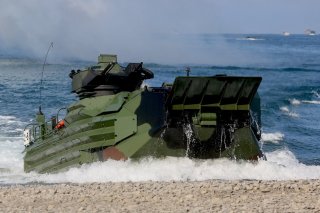Kill It or Build It? Navy and Marines Don’t Agree on the Light Amphibious Warship
The Marine Corps would, in essence, like a higher number of hulls at a cheaper price point, whereas the Navy would like to purchase a lower number of hulls at a higher price point.
The Congressional Research Service, a non-partisan think-tank that prepares information for the United States Congress, released a report on the United States Navy’s current force structure. While the weighty document contains essential information, some more newsworthy passages concern a future Navy project: the Marine Corps’ upcoming Light Amphibious Warship.
The Corps’ LAW is a crucial element for its Force Design 2030, a restructuring that would see the Marines shift from essentially a second land army optimized for fighting long, grinding land campaigns to a lightweight maritime force that would wreak havoc in littoral waters.
Sailing throughout the Western Pacific, small and highly decentralized groups of Marines would flit from island to island, denying their use for the enemy—even going so far as to sink enemy ships and submarines.
They would ride into battle on the Light Amphibious Warship, a small vessel with enough space to transport approximately seventy-five Marines and equipment throughout the Pacific. What the LAW ultimately looks like and its capabilities remains to be seen.
A Politico report quoted in the document explained that there is friction between the United States Navy and the United States Marine Corps.
“Some critics see the large ships as easy prey for Chinese long-range missiles, while being too big to get close to the small island chains of the Pacific to safely put Marines ashore and resupply them. Instead, the idea is for the Navy to get smaller, faster and develop more uncrewed systems,” the quoted report explains.
“But Navy Secretary Carlos Del Toro, a Biden appointee and retired naval officer, has been a proponent of keeping the number of amphibs around its current strength of thirty-one, a vision shared by Marine Corps Commandant Gen. David Berger who won support in Congress this year to block Pentagon plans to have the fleet shrink to twenty-five ships in the coming years,” the Politico report added.
However, “Marine and Navy leaders are at odds with each other over another issue: Berger also wants to add thirty-five new light amphibious warships to allow his Marines to move through island chains more quickly while presenting less of a target. That’s a vision Navy leadership has never fully supported,” it continued.
The Marine Corps would, in essence, like a higher number of hulls at a cheaper price point, whereas the Navy would like to purchase a lower number of hulls at a higher price point. The difference in cost can be explained by protection and survivability.
Costs aside, the heart of the issue may boil down to risk tolerance. While the U.S. Navy is loath for its ships and equipment to accrue battle damage, the Marine Corps assumes that losses—both in Marines and materiel—are an unfortunate but acceptable risk in fighting and winning battles.
Caleb Larson is a multimedia journalist and defense writer with the National Interest. A graduate of UCLA, he also holds a Master of Public Policy and lives in Berlin. He covers the intersection of conflict, security, and technology, focusing on American foreign policy, European security, and German society for both print and radio. Follow him on Twitter @calebmlarson
Image: Reuters.

